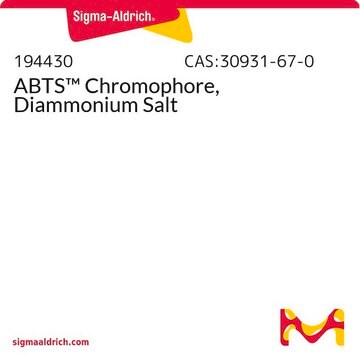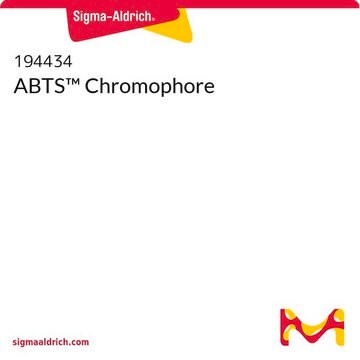11557
2,2′-Azino-bis(3-ethylbenzothiazoline-6-sulfonic acid) diammonium salt
chromogenic, ≥98% (HPLC), powder or crystals
Synonim(y):
AzBTS-(NH4)2, Diammonium 2,2′-azino-bis(3-ethylbenzothiazoline-6-sulfonate)
About This Item
Polecane produkty
product name
2,2′-Azino-bis(3-ethylbenzothiazoline-6-sulfonic acid) diammonium salt, ≥98% (HPLC)
Próba
≥98% (HPLC)
Postać
powder or crystals
zanieczyszczenia
≤6.0% water
rozpuszczalność
H2O: 10 mg/mL, slightly hazy to clear
temp. przechowywania
2-8°C
ciąg SMILES
[NH4+].[NH4+].CCN1C(\Sc2cc(ccc12)S([O-])(=O)=O)=N\N=C3/Sc4cc(ccc4N3CC)S([O-])(=O)=O
InChI
1S/C18H18N4O6S4.2H3N/c1-3-21-13-7-5-11(31(23,24)25)9-15(13)29-17(21)19-20-18-22(4-2)14-8-6-12(32(26,27)28)10-16(14)30-18;;/h5-10H,3-4H2,1-2H3,(H,23,24,25)(H,26,27,28);2*1H3/b19-17-,20-18-;;
Klucz InChI
OHDRQQURAXLVGJ-AXMZSLBLSA-N
Szukasz podobnych produktów? Odwiedź Przewodnik dotyczący porównywania produktów
Zastosowanie
- in the radical scavenging assay to test the antioxidant property of Pinus densiflora bark (PDB) extracts
- to test the antioxidant capacity (AOC) of Aloe vera samples
- as a substrate for streptavidin-horse radish peroxidase (HRPO) in enzyme-linked immunosorbent assay (ELISA)
Inne uwagi
Kod klasy składowania
11 - Combustible Solids
Klasa zagrożenia wodnego (WGK)
WGK 3
Temperatura zapłonu (°F)
Not applicable
Temperatura zapłonu (°C)
Not applicable
Środki ochrony indywidualnej
dust mask type N95 (US), Eyeshields, Gloves
Certyfikaty analizy (CoA)
Poszukaj Certyfikaty analizy (CoA), wpisując numer partii/serii produktów. Numery serii i partii można znaleźć na etykiecie produktu po słowach „seria” lub „partia”.
Masz już ten produkt?
Dokumenty związane z niedawno zakupionymi produktami zostały zamieszczone w Bibliotece dokumentów.
Klienci oglądali również te produkty
Nasz zespół naukowców ma doświadczenie we wszystkich obszarach badań, w tym w naukach przyrodniczych, materiałoznawstwie, syntezie chemicznej, chromatografii, analityce i wielu innych dziedzinach.
Skontaktuj się z zespołem ds. pomocy technicznej








